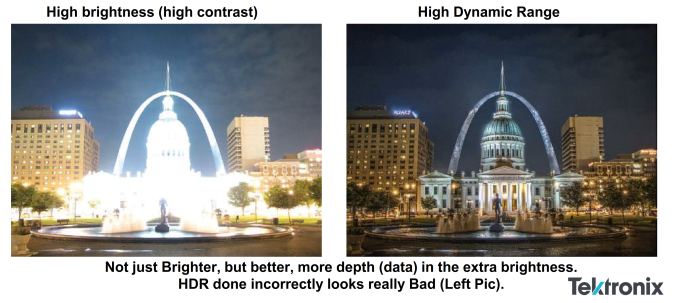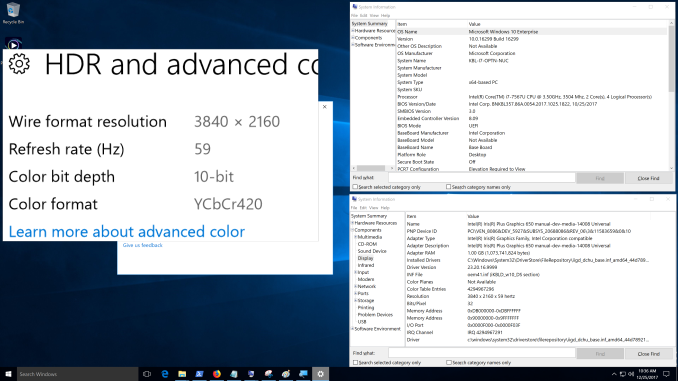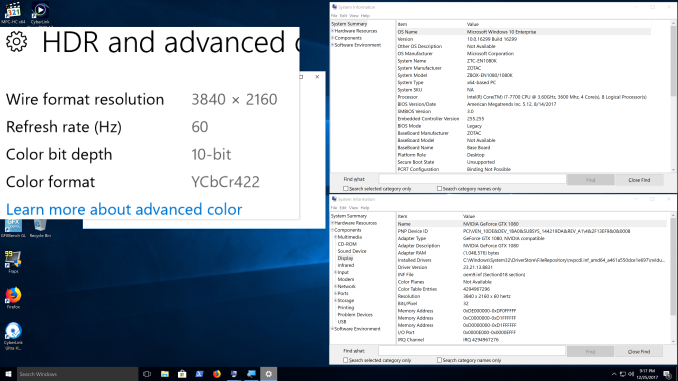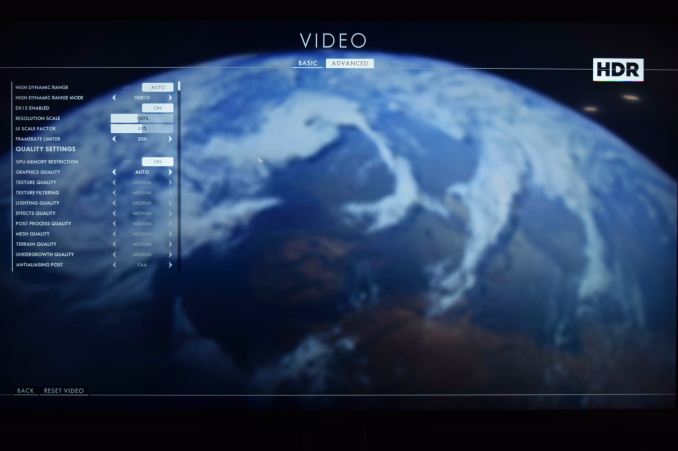A Budget Home Theater & PC Setup: 4K, HDR, UHD Blu-ray, and More
by Ganesh T S on December 26, 2017 8:30 AM ESTHDR Support
High Dynamic Range (HDR) is one of the most impressive features in the recent crop of 4K televisions. In layman's terms, it refers to the ability of a single frame to have wide variation in brightness for different regions. This allows the details in the dimly lit areas of the frame to be seen more clearly. Overall, it delivers a more vivid picture to the viewer. Note that this is quite different from the concept of high contrast.
Picture courtesy: SMPTE HDR Presentation from Steven Holmes of Tektronix
The ability of a display source to transmit HDR frames, as well as that of a display sink to be able to accept and understand them, can be gathered from the HDMI port's specifications. However, being able to accept and understand is only part of the problem. There are many low-cost 'fake HDR' TVs that simply parse the HDR information, but, do not have the ability to translate that to the display.
There are many HDR 'standards', with the base requirement being HDR10. Shifting a display sink into HDR mode involves the source sending some information (metadata) with the characteristics of the video being transported (the mapping of the pixel data to the displayed luminance, light levels in the video stream etc.). If this is static (i.e, done once when the shift to HDR mode occurs), it falls under the HDR10 category. Dolby Vision allows for the metadata to change on a frame-by-frame basis (dynamic). The upcoming HDR10+ standard will also support dynamic metadata. The takeaway is that Dolby Vision certification all but ensures a display with true HDR capabilities.
The TCL 55P607 comes with standard HDR10 and Dolby Vision support. The native Roku apps shift to the appropriate HDR mode based on the content being played back. We will analyze this more in the subsequent sections.
The NVIDIA SHIELD Android TV (SATV) is similar to the native Roku app in the TV with respect to treatment of HDR content. The main issue is that SATV doesn't support Dolby Vision yet, though there is a lot of clamor for it from SATV owners. Videos with HDR10 metadata shift the display to the appropriate HDR mode prior to playback.
PCs encounter additional challenges for HDR implementation. It is just not one company that is responsible for the feature. On one hand, the GPU driver vendors need to support it. On the other hand, the OS itself needs to provide hooks to enable HDR. Finally, the software ecosystem needs to catch up. The Windows 10 Fall Creators Update brought HDR10 capabilities for the Windows desktop into the stable ring. It also allowed streaming of HDR videos from YouTube and Netflix. Microsoft is continuing to fine-tune the HDR capabilities built into Windows 10.
Intel, along with CyberLink, had decided not to wait for Microsoft to deliver HDR on PCs. PowerDVD 17 was the first software Blu-ray player, and it only made sense for them to support HDR playback for applicable titles. The Intel / CyberLink solution for HDR when playing back certain Blu-rays in full-screen exclusive mode is orthogonal to Microsoft's HDR support.
The Windows 10 Fall Creators Update enabled desktop HDR and HDR video streaming on all the three test PCs described earlier.
HDR and Advanced Color Settings - Intel NUC7i7BNHX1 with Desktop HDR Enabled
The KBL-U platforms drove the display at YCbCr 4:2:0 10-bit, while the NVIDIA GTX 1080 drove the HDR output with higher quality (YCbCr 4:2:2 10-bit). For a good desktop experience, 4:4:4 is preferable.
HDR and Advanced Color Settings - Zotac ZBOX MAGNUS EN1080K with Desktop HDR Enabled
Gaming is not a focus in our HTPC reviews, but, we must give credit to NVIDIA for supporting Dolby Vision in their Pascal GPUs. Certain gaming titles such as Battlefield 1 support both HDR varieties (HDR10 and Dolby Vision), and the Zotac EN1080K is able to deliver it in a HTPC environment, thanks to its small form factor and relatively silent liquid cooling.
Battlefield 1 HDR Output from the Zotac EN1080K
Battlefield 1 Dolby Vision Output from the Zotac EN1080K
Unfortunately, Pascal's Dolby Vision support is available only in certain games, and is not applicable to streaming services like Netflix.
Microsoft's current approach to HDR with a desktop HDR mode is currently not efficiently implemented. For example, the desktop in the Zotac ZBOX MAGNUS EN1080K idles at 34.5W. With the HDR mode enabled, this jumps to 39.5W. In the KBL-U systems the penalty is of the order of 0.8W - 1W.















191 Comments
View All Comments
ddrіver - Wednesday, December 27, 2017 - link
If you have enough time reading them then I consider I'm doing a public service ;).Notmyusualid - Tuesday, December 26, 2017 - link
@ganeshtsTry to ignore ddriver - he could have an argument in an empty room.
ddrіver - Wednesday, December 27, 2017 - link
As long as it's a good argument? Why share a piece of crap with people when I can have a cake all by myself?Notmyusualid - Thursday, December 28, 2017 - link
@ ddriverEVERY possible argument seems to be a 'good one' for you.
Here, I think these people can help you:
https://en.wikipedia.org/wiki/Dignitas_(Swiss_non-...
Duckeenie - Wednesday, December 27, 2017 - link
Dude, seriously? Oxymoron?Crazyeyeskillah - Thursday, December 28, 2017 - link
There is nothing budget about this review. You are painfully out of touch with your readership. I've been on this website since 2001 and honestly don't know why I bother reading anything that isn't written by Ryan at this point. Really a shame what is left for Anands legacy.lmcd - Tuesday, December 26, 2017 - link
Given that the primary point of the article was the HTPC itself, there's literally no point in your comment except to continue your pattern of abuse. This is equivalent to talking about "storage on a budget" and using an expensive CPU to test the storage solution.ddrіver - Wednesday, December 27, 2017 - link
@lmcd: For your sake I hope you're pretty because you sure don't score any points on the IQ scale.The article is LITERALLY about "A Budget Home Theater & PC Setup". Not just "the HTPC itself". Reading comprehension fail. The article LITERALLY describes both. And although you may assume home theater is a wooden podium with really tiny actors putting on a play for you, it's actually not. A receiver is an integral part of a home theater. This is why the receiver is on the 3rd page of the article, before "the HTPC itself".
Which brings us to my gripe: a $1000 receiver and a $2000 HTPC recommendation are not budget by any stretch of the definition. Which means the very first part of the title is complete and total BS. Kind of like your understanding of the text... or words in general. Literally.
Reflex - Wednesday, December 27, 2017 - link
As usual reading comprehension is not your strong suite. The article lists two receiver options, one for $999 and one for $430. Nether is top tier nor considered 'expensive' in the receiver space. It offered three HTPC options, two which could be configured for $600-800, and one that was gaming focused for $2000. Again, perfectly reasonable budget options while highlighting the current cream of the HTPC gaming crop as an option for those with the budget.If I have a complaint about this article its that I'd have liked for them to offer one or two steps up on each category, for instance I chose to focus on the display for my setup and dropped $2k on a 65" OLED and then went cheap on the HTPC by using a XB1S.
None of the recommendations listed would be considered expensive, or even mid-range for the home theater space. Not even the $2k HTPC, honestly although it was the closest item. Mid-range in this space starts at around $20k, and goes up to around $200k before you get to the actual crazy setups (real home theaters).
But again, reading comprehension is not your strength, nor is knowledge of the areas in which you spout word salad like something sold by RonCo.
ddrіver - Thursday, December 28, 2017 - link
Oh Reflex, if only you paid more attention to making sense instead of just hurling whatever you pull out of your a$$.The fact that the author mentions another option once and then never describes anything related to it again is useless. If "mentioning" something was enough this article could very well have been a short table with the components needed. Basically the table on the last page (but one that actually lists the cheap AVR option).
Secondly, reviewing a "budget" setup where the actual receiver used is $1000 redefines the meaning of "budget". The $2000 HTPC must be a stupid joke only the author gets. Google for "budget receivers" and tell me what the ENTIRE INTERNET believes "budget" means. But I'm sure you're smarter than everyone else... in your own tiny head.
Only a bumbling moron can think these prices are "budget" because "midrange starts at $20000". And yeah, you refuse to actually read any of the comments that make good points here and prefer to focus on your own understanding of what I wrote, on rants about $20k midrange setups, and other stuff only you could think is reasonable. So you definitely fit that description.
But but but wait. $200k is actually entry level pocket change, far from a "crazy setup" you seem to think it is. Compared to real home theater systems:
https://www.theaterseatstore.com/most-expensive-ho...
https://www.octaneseating.com/most-expensive-home-...
But I need a good laugh. Keep going with your "knowledge". ;)